|


|

 |
|

|
|
Stainless beltline trim
(referred to as 'bright body side moldings' by the factory) was
optional an all models, including the Ranger, though the trim was standard for trucks
with a deluxe two-tone paint job. There were four different
styles of side trim used on Ford's '67-'72 light-duty trucks:
-
1967-only narrow
trim (1-1/4" wide)
This was the only style available in '67 on Custom Cab and
Ranger models. All models with two-tone paint got this trim, to
cover the area where the two paint shades meet. Not available on
base models except with
two-tone paint. This trim was also used on '68 trucks with serial
numbers up to #C56,001.
-
1968-1972
medium-width trim, black accents (1-1/2" wide)
This was the only style available for '68-'69 Custom Cab and
Ranger models. All models with two-tone paint also got this
trim, to cover the area where the two paint shades meet. The '70-'72 Custom (base model), Sport Custom and
Explorer models also used this
style if the "bright side moldings" option was requested.
-
1970-1972
wide trim, black accents (4" wide)
(Ranger and Ranger XLT only) This trim was considerably wider and completely covered the beltline bump.
-
1970-1972
wide trim, woodgrained accents (4" wide)
(Ranger XLT only) Only Ranger XLT models could get the wider
trim with woodgrained accents, which matched the tailgate and
dashboard trim appliqués.
|


Fig. 1 - 1967-only
narrow trim

Fig. 2 - 1968-1972 medium-width trim

Fig. 3 - A side-by-side comparison of the narrow and medium-width
styles

Fig. 4 - 1970-1972 Ranger XLT wide trim w/woodgrained accents
|
|
 |
|
Fig. 5
- The wide trim style used on '70-'72 Rangers and Ranger XLT trucks had a
cut-out at the rear to accommodate the rear marker light (above right).
If a similar-year truck was equipped with the medium-width trim, the
trim stopped in front of the marker light (above left). Both examples
here are 1972 models. (NOTE: The Explorer emblem shown above is a
one-year-only item for the '72 models. Explorer models from previous
years had no exterior emblems, though some did have a glovebox emblem.
'73-up Explorer models had a similar box emblem, but was slightly
different.) |


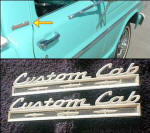
Fig. 8 - On top is the '67 emblem, on bottom is the
'68-'69 emblem |
There were three trim levels available for '67-'69 trucks: base, Custom Cab and
Ranger. Base models had no exterior or interior model insignias.
1967-1969 Custom Cab models had these emblems mounted just
behind the doors on each side. The '67 emblems had red accents
whereas '68-'69 versions were accented with black. |
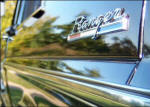
Fig. 9 - The '67-'69 Ranger emblem, mounted at the rear
of the bed on each side |

|
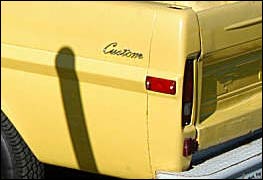
Fig.
10 |
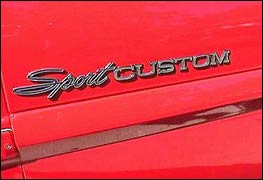
Fig.
11 |
|
There were four trim levels available for '70-'72 models:
Custom, Sport Custom, Ranger and Ranger XLT. The mid-year
'Explorer Special' models had no exterior identification, except
on the '72 models (see Fig. 5 above). |
|
 |
|
Fig.
12 - The 'Ranger' script for the '70-'72 trucks was redesigned,
and could also include the additional separate 'XLT' emblem. |
|
|
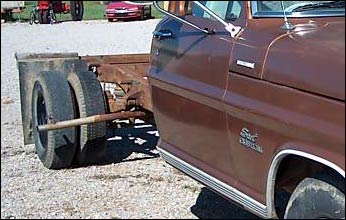 |
Trucks which were delivered from
the factory without a standard pickup bed, such as a
chassis/cab, flatbed, etc. had the model emblems
mounted on the front fenders, like on this '72 F350
Camper Special ex-motorhome. |
|

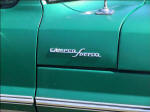
Fig. 13 -
The 1967 Camper Specials had emblems mounted up on the
side of the cowl panel. |
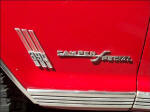
Fig. 14 -
The 1968-1969 Camper Special emblems were moved down to the
lower front fender. |

Fig. 15 -
The '70-'72 Camper Special emblems were redesigned and moved
back up to the side of the cowl panel.

Fig. 16 |

|
Here
are two different styles of emblems used on the '70-'72 Crewcab trucks
(earlier crewcabs had no emblems).
These would also be mounted on the sides of the cowl panel (see
Fig. 15). |

Fig. 17 - 1970-only emblem |
|

Fig. 18 - 1971-1972 emblem |
|
NOTE: I'm still researching the correct usage of these emblems.
Fig. 17 is on a '70 F250 and Fig. 18 has been seen on a '71 F350
and a '71 F250, leading me to believe that the top version was
the '70-only version and the lower version used in '71-'72.
Also, these emblems should have elements of color in them,
similar to the gold in the Camper Special emblem in Fig. 16 above (I
believe). If you can supply better examples of what I have
pictured here or any additional info regarding correct model
year or trim level usage, please
e-mail me. |

|
1969
Contractor Specials decal |

Fig. 19 |
|
1969 Farm & Ranch Specials
decal
C9TZ-16720-C |

Fig.
20 |
|
1970-1972
Heavy Duty Special |

Fig.
21 |
|
The
1970-only Farm & Ranch emblem
D0TZ-16720-A |

Fig.
22 |
|
The
1970-only Contractor Special emblem |

Fig.
23 |
|
1968-'69 trucks equipped with a 390 c.i.d. engine
got special emblems mounted on the front fenders.
Regardless of whether it also had Camper Special
emblems or not, they were mounted in the same place.
These were the only trucks of the '67-'72 era which
had any kind of engine displacement emblem/decal. |

Fig.
24 |
|

|
The
'67-'69 base or Custom Cab models did not have a glovebox
emblem, nor did the '70-'72 Custom (which was the base model
for those years). |
|
'70-'72 Sport Custom emblem, for trucks without the
Explorer trim package |

Fig. 25 |
|
Some
'70-'72 Custom and Sport Custom models equipped with the
Explorer trim package got this emblem |

Fig. 26 |
|
(Note: I've seen more verified factory Sport Customs and Explorers which do not
have any glovebox emblem vs. those that do....no explanations
to offer.) |
|
'67-'72 Ranger emblem |

Fig. 27 |
|
'70-'72 Ranger XLT emblem |

Fig.
28 |


|
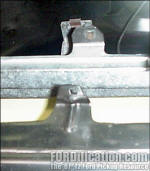
Top: '70 grille shell
Bottom: '71-'72 grille shell
Fig. 35 - In this picture you can see the
differences in the length of the grille insert
mounting tabs. In addition, there are variations
in the physical locations of the mounting tabs. |
The '67-'69 versions are 3 basic pieces: the grille shell
and the two headlight doors. The '70-'72 grilles are 5
pieces: the grille shell, the two headlight doors, and two
plastic grille inserts. In addition, the '71 grille
assemblies had two horizontal chrome strips, one for each
side. All grilles were available in either steel or
aluminum versions.
NOTE:
The grilles used on the '67-'72 trucks are interchangeable
as a complete assembly. That is, you can put a '67 grille
assembly onto a '72 and vice versa...it's a simple bolt-on. However, the '67-'69 grilles and the
'70-'72 grilles cannot mix parts.
Mounting a '70-'72 grille assembly on a '67-'69
truck requires you also use the later lower
valance panel, which has wider turn signal
indicator notches. (See the 'Lower Valance
Panel' section on Page 2 of 'Identifying
1967-1972 Ford Pickups' for more
information.)
Fig. 35 (left) illustrates the differences in
the length of the grille insert mounting tabs
between the '70 and '71-'72 shells. In addition
to the two extra mounting tabs on the '71-'72
shells, the four main tabs on each side are
spaced a little differently. The top two are
close, but the bottom two are very different. |
|
|
The 1967 grilles consisted of 6 equal-sized and
equally-spaced horizontal bars, and the turn signal
indicators are integral. Standard cab and Custom Cab models got a
steel grille assembly, whereas the Ranger models got an
all-aluminum version. There was no Ranger grille emblem for
that model. There was no accent paint anywhere on either
version. |

Fig. 36 - '67 standard and Custom Cab models |

Fig. 37 - '67 Ranger models |
|
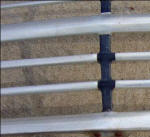
Fig. 38 - '68 Custom
Cab models, close-up |
The 1968 grilles consisted of 7 bars. The top, middle
and bottom bars were wide, with two thinner bars between the
top/middle and middle/bottom. Base models got a steel grille
assembly and the Custom Cab models could get either a steel
or all-aluminum version. The Ranger models got an
all-aluminum version with a Ranger emblem mounted on the
center bar. Both grille styles had black accent paint on the
vertical grille bar supports, to give the impression of
'floating' horizontal bars. |

Fig. 39 - '68 Custom Cab models |

Fig. 40 - '68 Ranger models |
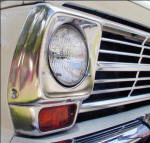
Fig. 41 - 1969
non-Ranger
close-up |

Fig. 42 - '69 Ranger
close-up |
The 1969 grilles were identical to the '68 grilles,
except that there was no accent paint on the vertical bar
supports, and the center bar had a groove along the top. The
groove was painted red for the Ranger models but left
unpainted for all others. Standard cab got a
steel grille assembly, whereas the Custom Cab and Ranger models got an
all-aluminum version. Ranger grilles have a Ranger emblem mounted on the
center bar and blacked-out headlight doors which have a
pronounced ridge around the edge of the black accent paint
and are unique to the '69 Ranger. |

Fig. 43 - 1969 standard and Custom Cab |

Fig. 44 - '69 Ranger models |
|
The 1970 grilles were completely redesigned, with a
new shell and new headlight doors. The turn signal
indicators are now mounted on the valance panel, and are
visible from either the front or the side. All models got
the same version: an all-aluminum grille shell with
removable plastic inserts with a grid pattern that are
interchangeable side-to-side. There was no longer a
grille-mounted Ranger emblem. Also, there are two different
'70 shells. Before Ser. J30,001 the shell used inserts that
were right/left specific. After Ser. J30,001 the new grill shell
(D0TZ-8200-D) used the same inserts for right/left. |

Fig. 45 - '70, all models |
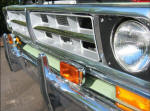
Fig. 46- '71, all
models, close-up |
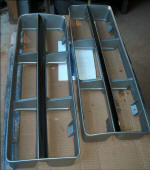
Fig. 47 - '71
NOS grille
insert |
The 1971 grille assemblies again had a redesigned all-aluminum
grille shell and completely different plastic inserts,
which included two vertical bars and a single horizontal bar
with a chrome strip for each side. There was only one
version for all truck models. |

Fig. 48 - '71, all models |
|
The 1972 grille assemblies were identical to the '71
versions, except that the plastic inserts were slightly
different, with a single horizontal and vertical bar for
each side. There was only one version for all truck models. |

Fig. 49 - '72, all models |
|
NOTE: The
'71-'72 plastic grille inserts are interchangeable between those two years,
but each year has a right-side and left-side
piece, so they cannot be swapped side-to-side. |

|
1967-1969
1967 styleside tailgates were not available with a filler panel.
The tailgates on standard-cab trucks were either plain (with no
chrome trim) or, if with a two-tone paint job, they had a single
chrome strip along the base of the tailgate, where the two
colors met. Ranger tailgates were equipped with stainless
perimeter trim and chrome tailgate release handles.
1968-1969 tailgate trim was identical to the '67s, except that
in addition to the perimeter trim, the Ranger models also got
the argent filler panel (C8TZ-99425A34-A),(Fig. 51). This trim
was also used on 1970 models with serial numbers before F70,001.
|
Filler panel dimensions |
|
Style |
Dimensions |
Letter Height |
|
Black or argent |
61-7/8" x 5-1/8" |
3" |
|
Full-size |
66¾" x 12-1/8" |
3-5/8" |
|

Fig. 50 - Single chrome strip with two-tone paint |

Fig. 51 - '67 full perimeter trim |

Fig. 52 - '68-'69 Ranger - full perimeter trim with
small argent filler panel (also used on early-'70 models) |
|
Additional Tailgate Information |
|
The '64-'66 tailgate WILL interchange with the
'67-'72 trucks and the body lines will be correct.
However, note the difference in the letters. The
'64-'66 letters are of a sans-serif style font,
whereas the '67-'72 letters are of serif font. |

Fig. 59 - '67-'72 style tailgate on a '73-'79 pickup.
While the two generations do have interchangeable
tailgates, the body lines will not line up
correctly. |
|

Fig. 57 - This is a correct
'64-'66 tailgate |

Fig. 58 - '67-'72 style tailgate
on a '66 F-100 |
|
 (Fig.
60) - '73-'79
tailgates have an argent tailgate filler panel which
at first glance is similar to those used on the
'68-'69 trucks, but the panel is smaller (only about
55-3/4" wide) and uses a
sans-serif font. (Fig.
60) - '73-'79
tailgates have an argent tailgate filler panel which
at first glance is similar to those used on the
'68-'69 trucks, but the panel is smaller (only about
55-3/4" wide) and uses a
sans-serif font. |
|
NOTES: I'm still researching additional details
regarding the correct model usage for the chrome tailgate
release handles. Also, the general trim parameters listed above
are correct, but an individual ordering a truck could have
specified some trim that wasn't standard or deleted from his
order some trim that was. There really is no written-in-stone
mandate on any of these, and the above information is to be used
for general reference only. The only exception to this that I'm
aware of is that '70-'72 Ranger and Ranger XLT tailgate trim
were for those trim levels ONLY and could not be added to Custom
or Sport Custom models. |
|
|
|
 |

Want to link to
this site? Please save this banner to your hard drive to place on your
webpage.
The correct link to use is
http://www.fordification.com
|